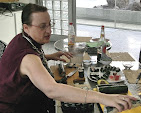Recipe
When are they from?
Now, there is a really good
question, which sadly I cannot provide a definitive answer to! The
Oxford Encyclopedia of Food and Drink in America says that wafers
“date back to ancient Greece, where they made obelios, a flat
cake cooked between two hot metal plates.”
The earliest image I
have spotted so far is from the Velislav Picture Bible (between 1325
and 1340)
What are they made of?
The basic wafer is pretty
simple: flour, eggs, wine, salt.
But... you could get fancy, such
as by stuffing them with cheese or adding ginger to the paste.
Saffron wafers are mentioned in royal accounts from medieval
Poland.
By the late 16th or early 17th century they
might contain sugar and flavourings such as rose-water and cinnamon.
A set of books in Gent, Belgium (bound together as one) dating from
about 1560 has recipes that are made using white bread crumbs instead
of flour.
What tool is used to make them?
They did come in different shapes and sizes (including round), but this picture is quite a typical example of a medieval or renaissance wafer iron.
As you can see in this picture, there are two different sides. From my travels and research, they always seem to have two different sides in the medieval period – modern ones don't always. If you would like to see more examples of wafer irons, visit: www.larsdatter.com
When in the meal were they eaten?
They appear to have been served quite
late in the meal, both in England and in France, and it seems, always
with hippocras! There is a theory that they are a sort of final
blessing at the end of the meal.
In Le Menagier de Paris
(1393) the author gives details of the arrangements for two
wedding feasts that include wafers. In both he lists them as being
right towards the end of service, which goes in essentially this
order:
- Service (butter, little pastries and fresh fruit)
- Pottages
- Roasts with sauces
- Entremets (jellied meats)
- Dessert (NOTE: not as we know it: frumenty, venison, pears and nuts)
- Issue: hippocras and wafers
- Boute-hors (translates literally as bottle out): spiced wine
Over the sea in
England John Russell writes in about 1440i&
þañ with goddes grace þe fest wille be do.
Blaunderelle, or pepyns, with arawey in confite,
Waffurs to ete / ypocras to drynk with delite.
now þis fest is fynysched / voyd þe table quyte
This basically says that after you have eaten the wafers and
drunk the hippocras, you should leave the table.
How many wafers did people eat?
For the wedding feast Master Helye gave on a
Tuesday in May for 40 people, altogether they ordered 18 stuffed
wafers, 18 gros bastons, 18 portes, 18 estriers and a
hundred sugared galettes.ii The
final negotiation with the pastrycooks however, provided for 4 wafers
for each guest.
It is worth noting that the gros bastons were the
most expensive – I wonder if this is because they were simply
larger, or perhaps were filled with something?
On the hippocras
front: Le Menagier notes that two quarts of Hippocras was considered
too much for a party of 14 guests: - a half pint between three people
was considered to be sufficient.
Who made them?
Wafers appear
to have been made by specialised Pastrycooks. In France they were known as Obloyeurs (Oubloier - also
spelled Oubloiier in medieval French or Obloyeurs) or Gauffriers –
specialist wafer makers.






No comments:
Post a Comment